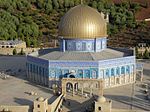
Summary
Mini Israel (Hebrew: מיני ישראל) is a miniature park located near Latrun, Israel in the Ayalon Valley. Opened in November 2002, the site contains miniature replicas of hundreds of buildings and landmarks in Israel. The tourist attraction consists of about 350 miniaturize models of notable buildings. The scale of 1:25 produces skyscrapers that tower over an adult and historic churches taller than a child.[1][2]


Overview edit
The permanent exhibition shows the main sites and structures in Israel of importance to Judaism, Christianity, and Islam. The sites are of historical, archeological, cultural, religious, and ethnic importance, depicting the sites and the ethnic groups associated with them, such as different Muslim cultural groups, Jews and Christians living in the country, but also Druze, Bedouin and others.[3] The signs are in Hebrew, Arabic, and English.[4] 95% of the visitors are Israeli.[4]
The complex covers 60,000 square metres (14.8 acres),[4] with the models displayed over 35,000 sq m (8.6 acres). The park also includes a souvenir shop, a few restaurants and rest areas, and a hall for lectures and meetings in which a film about the creation of the park is displayed. An audio guide[3] and motorised buggies are available.[4]
History edit
The slogan since its inception has been "See it all - small".[3] The designers, architects and model builder team consisted of over 100 people from all parts of Israeli society and religions, including many new immigrants from the former USSR. The park was the brainchild of Israeli entrepreneur Eiran Gazit who conceived the idea after visiting the famous miniature town of Madurodam in the Netherlands in 1986.[5] Delayed by the First Intifada, Gazit began plans to build the park in 1994.[5] The park was created by Gazit and his partners, with Yoni Shapira serving as creative and marketing director,[5] Mike Madeson in charge of international projects, and Koby Plashkes as technical director. It was funded mainly by two large investing groups: Granite HaCarmel and Secom of the Shikun Ubinui Group. It cost $20 million USD, with 15% of the funding coming from the Israel Tourism Office.[4] The park was built on land owned by Kibbutz Nachshon.[4] It had 350,000 visitors in its first nine months of opening.[5] A Google Street View of Mini Israel was completed in November 2011, becoming active on April 19, 2012.[6]
The models edit
The park consists of about 350 buildings and landmarks, 30,000 figures, 500 animals, plants and 15,000 real trees, 4,700 cars, 100 motorbikes, 14 trains, 3 helicopters, 32 aircraft, 175 ships and 230 trucks. All trees are real bonsai cultivated and planted by Agronomy nursery.[3] The park is loosely shaped like a star of David,[2] with each of the six triangles representing an area or city: Jerusalem; Tel Aviv; Haifa; Galil; Negev; Center. Models were created in workshops spread throughout Israel using sophisticated computerized evaluations, based on research prepared by Mini Israel staff.
Most of the buildings were built in the scale of 1:25. Exceptions are Nahalal - 1:250; Orot Rabin power station - 1:50; walls of Jerusalem and Acre reduced to 1:50 leaving their height at 1:25; Knesset Menorah - 1:15
The models are made of polyurethane or similar polymeric materials, and small stones. They were painted with waterproof paint for resistance to weather conditions. Many of the models include kinetic moving parts such as trains, planes, a soccer game, heavy equipment, boats, etc.
Mass grave edit
On the grounds of the park is the unmarked mass grave of about 80 Egyptian commandos who were killed nearby during the 1967 Six-Day War.[7] The commanders included 25 who burnt to death in a wild fire.[7] An attempt to publish this information in the 1990s was forbidden by the military censor, but the suppression order was lifted in 2022.[7]
Gallery edit
-
-
-
-
-
-
-
-
-
View of the Mini Israel
-
-
-
See also edit
- Kasol, India resort often termed "mini-Israel"
References edit
- ^ Walz, Steve (28 May 2010). "Israel: A Summer Like You've Never Experienced Before". The Jewish Journal of Greater Los Angeles. Archived from the original on 2010-06-03. Retrieved 14 June 2010.
- ^ a b "Mini Israel". Haaretz. 25 March 2008. Retrieved 14 June 2010.
- ^ a b c d "Mini Israel". Jerusalem Post. 25 January 2010. Retrieved 14 June 2010.
- ^ a b c d e f Oestermann, Richard (2006). Every second counts: true stories from Israel. Gefen Publishing House Ltd. p. 123. ISBN 965-229-359-8.
- ^ a b c d Veeder, Nechama (22 August 2003). "Homage to the holy land". Jerusalem Post. Retrieved 14 June 2010.
- ^ Mini Israel on Google Street View
- ^ a b c Adam Raz (July 8, 2022). "Revealed: Dozens of Egyptian Commandos Are Buried Under an Israeli Tourist Attraction". Haaretz.
External links edit
- Mini Israel - Official website
31°50′32.97″N 34°58′2.1″E / 31.8424917°N 34.967250°E


